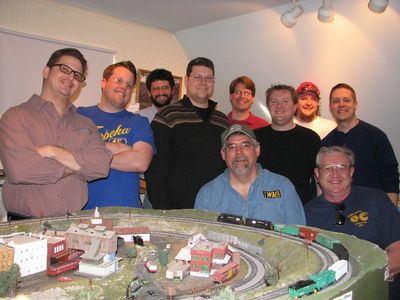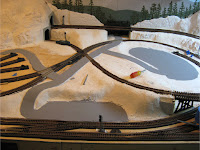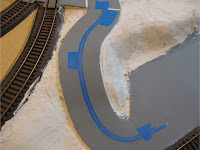
As I go about the messy business of rebuilding a major portion of my model railroad, I'm beginning to struggle with the question of just exactly what I'd like my layout to be. The original design is a wonderful tangle of main line, yard, branch line and industrial operations. And even in its present confused state, it serves well the social interaction that model railroad operations can be.
At any given session, I can have 4 to 10 crew jammed into my layout room, and everyone (for the most part) has a job to do. In fact, without that formidable staff, sometimes it's difficult to justify even turning on the lights in there. I do go in and tinker, and will on occasion set the turnouts for a closed route and enjoy watching a train circulate. But I'm trying to come to terms with the idea of having all this stuff, and questioning whether I'm really enjoying the layout the way I want to.
My operations plan is, admittedly, heavily influenced by the fact that I live at least a couple of hours from most of my crew. They travel a good distance to run my layout, so I feel compelled to provide them with a solid "play value" for the time they have invested. Thus I have staging areas that can hold hundreds of cars, lots of money tied up in switch motors, DCC throttles, and let's not even get started on rolling stock. In between sessions, I'm faced with building the new this, or rewiring the faulty that... and of course, cleaning engine wheels.
Now don't get me wrong, I like running those hot freights from one staging track to another. I love sorting cars and assembling trains in the yard, then sending them on their way. I really like switching my big industries, and that drag of empty hoppers needs to get back to the tipples...
But am I biting off more than I really want to chew? It would probably help if one or two guys lived closer, and could come over on a Tuesday night to help take care of the tedium. Or if I was an hour away, instead of two plus, so I could expect to fire up the layout more than three or four times a year. Right now, it seems a to be a lot of buck for the bang.
So, what to do? Do I go ahead and blast the whole shootin' match and start fresh on a simple short line that I can get my head around? Do I revisit the master plan, and see if it can be made to work with fewer hands (and dollars?)
My fear is that by scaling back to a railroad that looks, fits and runs better for one guy in a relatively small space, that I'd be sacrificing the opportunity to have those great ops sessions where guys come from far and wide to have a good time at my house. (A bit narcissistic, but then aren't we all?)
I'd also miss the variety of operations that I enjoy. While I think I'd love to build a simple branch line serving a handful of customers with a heavily weathered geep, I might also get terribly bored with it after a few times of doing the same thing over and over and over...
I suppose the only real answer is to press on with the master plan, and when the urge hits to run that rusty switcher, I'll just turn on the branch line and let the rest of the layout sleep...
























 With a bit of consideration, I decided that the next step of my layout would be the roads. As always, I researched the subject online and found that the most effective method would be to build forms and pour the roads with a plaster product. First however, I needed to plan where my roads were going. I determined my road width at 2 ½”, and cut a square piece of cardstock the same width. After drawing the contour of one edge of my planned road directly on my layout, I used the template card to draw the opposite edge. This allowed me to ensure the road was always 2 ½” wide.
With a bit of consideration, I decided that the next step of my layout would be the roads. As always, I researched the subject online and found that the most effective method would be to build forms and pour the roads with a plaster product. First however, I needed to plan where my roads were going. I determined my road width at 2 ½”, and cut a square piece of cardstock the same width. After drawing the contour of one edge of my planned road directly on my layout, I used the template card to draw the opposite edge. This allowed me to ensure the road was always 2 ½” wide.
























